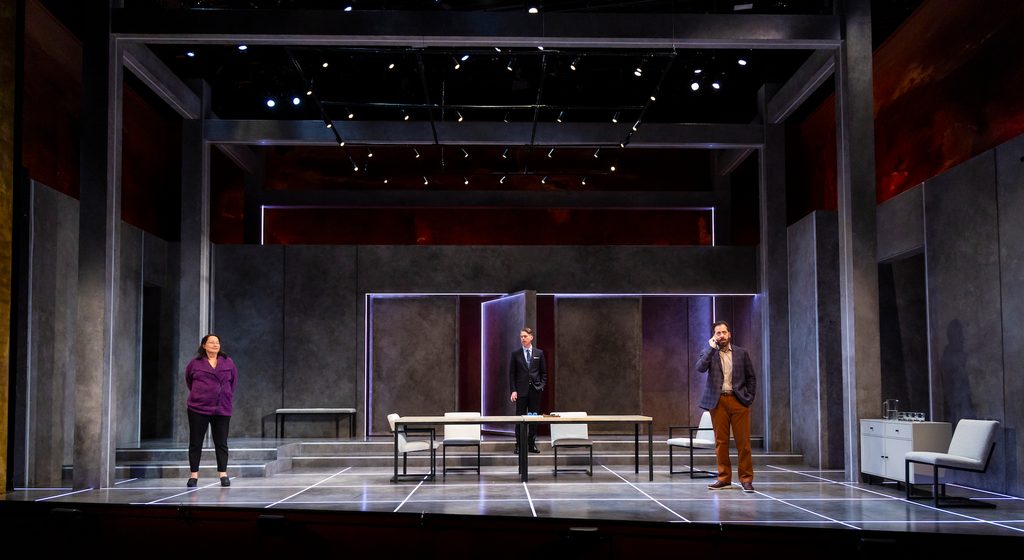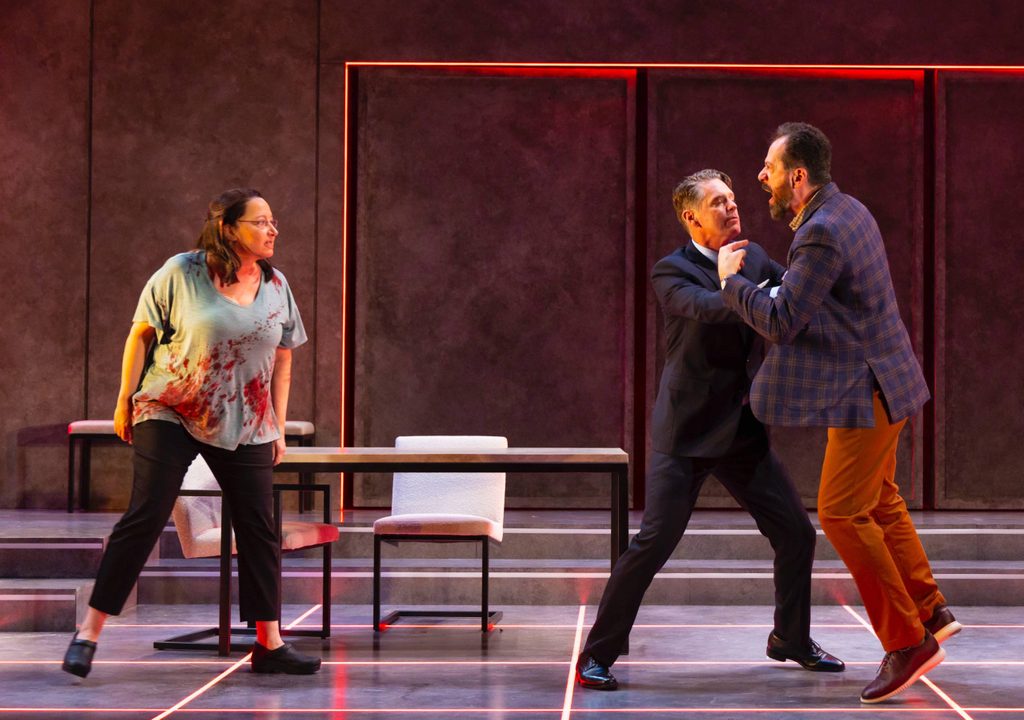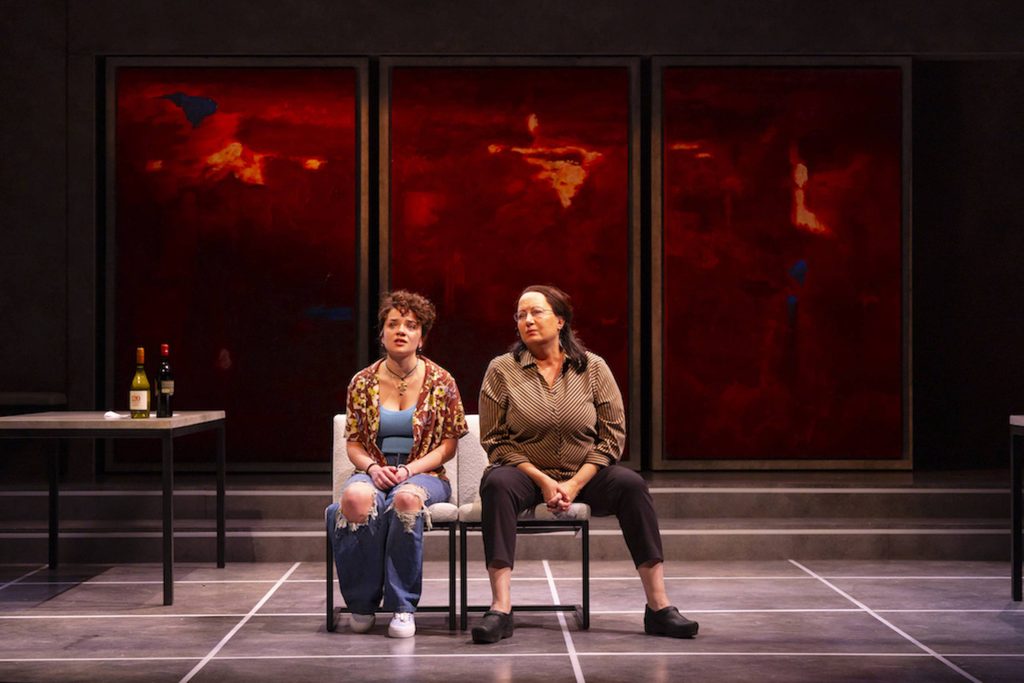
Photo Credit: T Charles Erickson
“The Art of Burning” by Kate Snodgrass. Directed by Melia Bensussen. Scenic Design: Luciana Stecconi; Lighting Design: Aja M. Jackson; Sound Design: Jane Shaw; Costume Design: Kate Harmon. Presented by The Huntington, Calderwood Pavilion at the BCA, 527 Tremont Street, Boston through February 12.
by Shelley A. Sackett
Patricia (Adrianne Krstansky), a frumpy middle-aged painter, opens Kate Snodgrass’ ‘The Art of Burning’ mid-conversation with her friend Charlene (Laura Latreille). “Sometimes we have to kill the things we love to save them,” she announces seemingly out of the blue. Charlene adds critical context. The two have just seen a production of “Medea” and are debriefing outside the theater.
In the ancient Greek tragedy by Euripides, Medea takes vengeance on her unfaithful husband Jason by murdering his new younger wife as well as her own two sons, after which she escapes to Athens to start a new life. To Charlene’s discomfort, Patricia not only sympathizes with Medea, she praises her.
“She saves her children,” Patricia explains. “She doesn’t want to but she has to. The world will make their lives miserable and she doesn’t want that. She loves them.” Patricia may look mousey, but she is a mouse that roars.
Under Melia Bensussen’s fast-paced direction, the audience is quickly brought up to speed as the brilliantly designed (Luciana Stecconi) and lit (Aja M. Jackson) set morphs into a conference room. This is the divorce war room. Patricia’s husband Jason (groan…) has – you guessed it! – left her for a younger woman (Vivia Font). Jason (Rom Barkhordar) has enlisted Mark (Michael Kaye), a family friend and Charlene’s husband, to mediate their contentious divorce despite glaring and unethical conflict of interest.

While waiting for Jason to arrive, Patricia continues her tribute to Medea, much to Mark’s discomfort. The more Mark squirms, the more Patricia rhapsodizes. Adding to the slow burn are these facts: Patricia recently torched Jason’s antique desk on their front lawn and their divorce hinges on who will have custody of their 15-year-old daughter Beth (Clio Contogenis). As the animosity and toxicity of their marriage is revealed, the audience feels increasingly sorry for the teenager who must choose between these two. “Custody” in this context feels more like incarceration than protective caregiving.
Through Patricia’s unhinged tirades, Snodgrass seems to want us to wonder whether she is grandstanding or has become so untethered that she imagines herself a 21st century reincarnation of the Greek cuckolded princess. Unfortunately, the characters are too undeveloped and the play too full of clichés and tropes to create the kind of tension required to pull off this level of subtle, emotion-driven drama. Instead, the audience is served up a contemporary look at conflicted, flawed characters who are doing the best they can, more of a slow roasted marshmallow than daring flambé.
Which by no means suggests that the 85-minute intermission-less play should be ignored. Snodgrass raises important issues and the cast capably rises to the occasion. She adds meat to the play’s bones through the interactions between mediator Mark and Charlene (played with comic spunk by a splendid Latreille), who are going through their own marital bumps. Their scenes together bring a chemistry and ease that underscore the tedium of Patricia and Jason’s cardboard, rancorous communication.
As Patricia, Krstansky delivers her pithy lines with a deadpan earnestness and impeccable timing that hints at the blaze raging inside her. The more controlled she appears, the more hysterical her character reads. Kudos to the talented actress for pulling off this marvelous feat.

Her scenes with daughter Beth (Contogenis brings a welcome multi-dimension to the role) are among the most meaningful and poignant. Beth tries to explain to her mother that her anxiety and discomfort go way deeper than reactions to her parents’ divorce and normal teenage growing pains. She is that Gen-Z “woke” teen who viscerally feels the existential crisis of the world with every pulsating neuron in her body. She lives in a constant state of fear and disgust and marvels at the psychological trauma inflicted upon her by her clueless parents’ irresponsible childrearing.
Poor Beth, it seems, is the fulcrum of her parents’ dysfunctional marriage. How and why the two ever got together, let alone thought they could parent, becomes even more a mystery as Beth fills in the gaps.
Unlike Jason, Patricia finally listens — and really hears — her daughter after a pivotal interaction where she faults her Beth’s outfit for provoking sexual date abuse. “Guys never get blamed, Mom. You don’t know. You don’t get anything!” Beth cries. All Patricia can demurely offer is a heartfelt, “I’m just trying to help.” By the end of the play, the path these two bravely forge together is the most inspiring and meaningful of all the characters’ relationships, and the coals post-theater discussions love to fan. For tickets and information, go to: https://www.huntingtontheatre.org/whats-on/the-art-of-burning/

